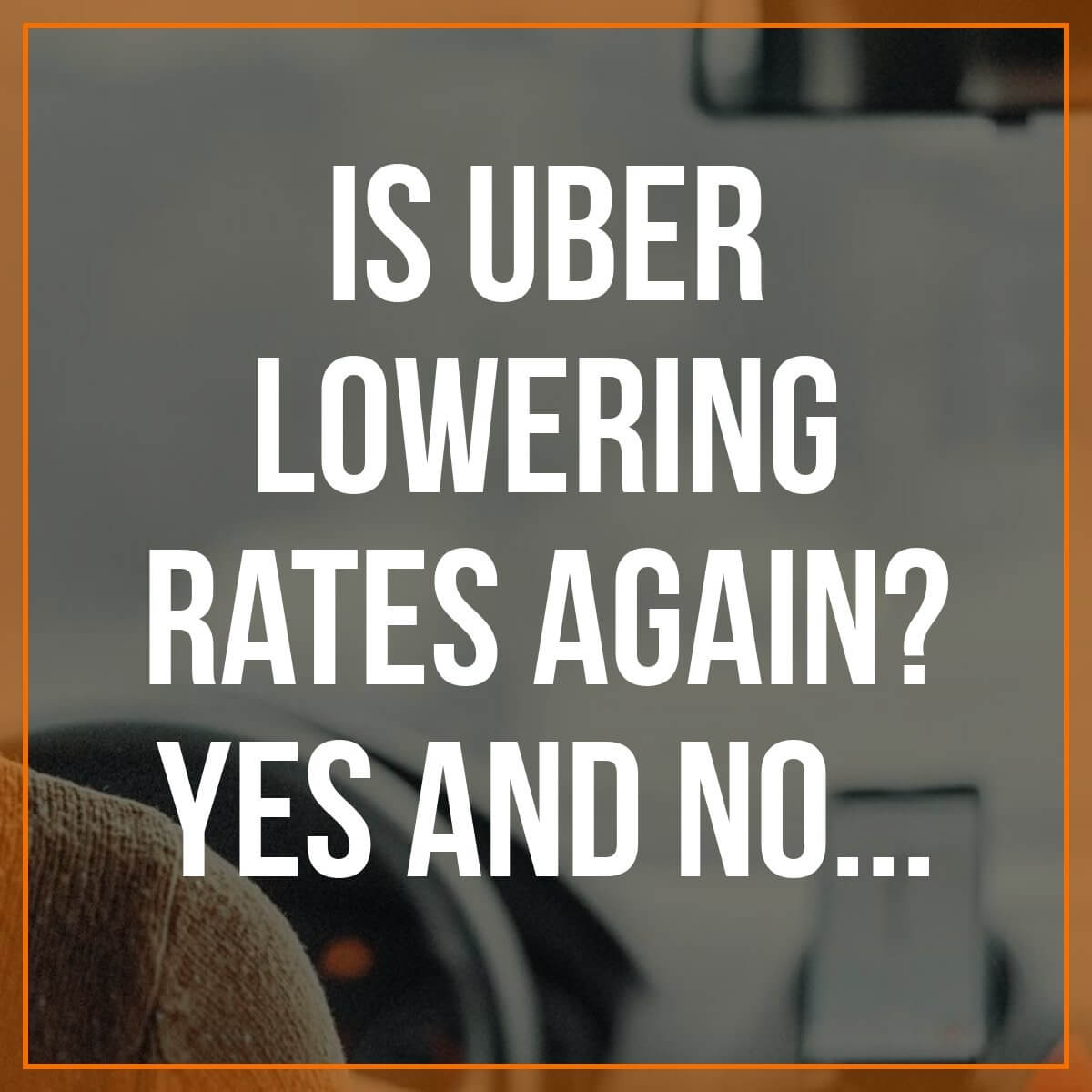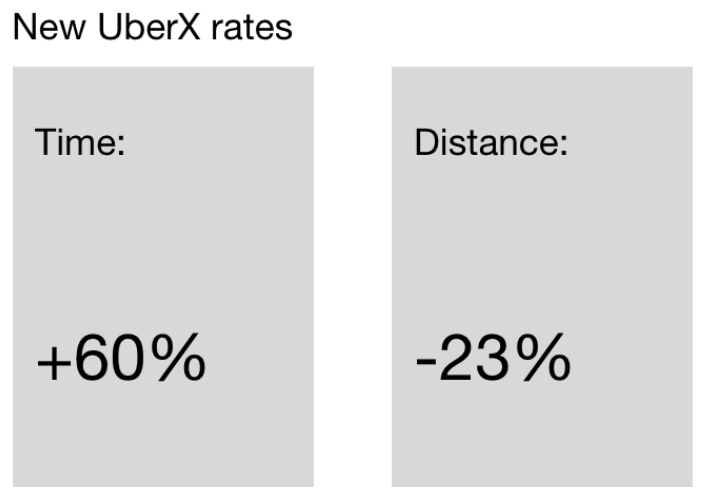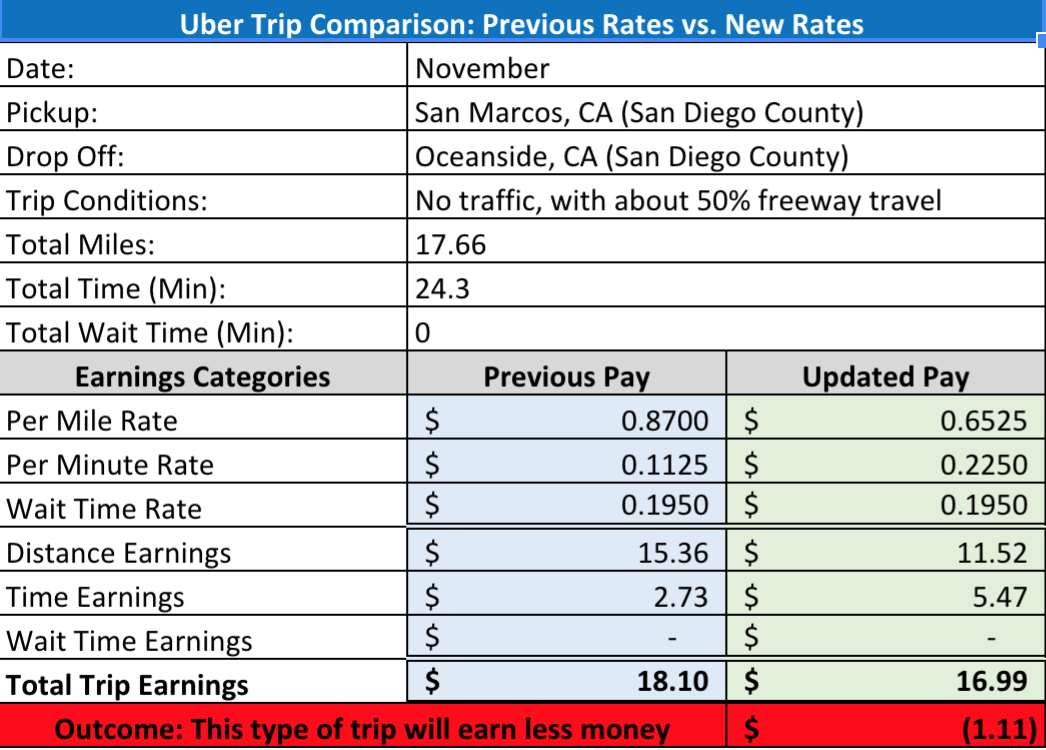Over the past 2 years, Uber has been making rate changes nationwide. If your city hasn’t been affected by rate changes yet, it likely will be. Here is an updated list of the cities that have been affected by the rate changes. Below, we also have a spreadsheet you can use to calculate how your rates have changed.
Earlier this year we covered Uber’s new rate changes in certain cities nationwide. Uber is calling this program ‘dependable earnings’ and says these new rate changes are designed to “value your time on the road.” Dependable earnings now looks like it is rolling out to more cities across the US, as evidenced by the emails we’ve received and the discussion on Facebook groups.
Based on Uber’s e-mail to drivers, the company is ‘updating rates to better value your time’. But the messaging is eerily similar to what we’ve seen in the past when Uber has lowered rates and told drivers that we’d earn more – which turned out to be false. Who would have thought?

Although the exact numbers vary by market, one reader from Portland, OR shared his new UberX rates:
New UberXL rates:
And new UberPool rates:
Andrew in southern California shared these rates:

These are not the only markets affected by far, however. We’ve heard from drivers around the country, which means Uber is rolling this out nationwide. If rate changes haven’t come to your market yet, they are.
How Will This Impact Drivers?
RSG reader Andrew from southern California shared an in-depth analysis of what this will look like for drivers in his market. In addition, Andrew created a spreadsheet for you to use to see how rates will impact your earnings based on your rate/distance changes.
In Andrew’s words,
“Uber recently updated the pay rates for drivers. In their email to driver partners they told us, “We know that when you’re stuck in traffic or moving slowly due to unexpected delays on a trip, it may not feel worth your time, so we’ve made a few exciting changes. Starting today, you’ll see updated rates for time and distance.” The email goes on to tell us that they kept our (drivers) best interest in mind–apparently these rate changes are kind of like an early Christmas gift because Uber wants to give drivers more predictable, steady earnings.
Needless to say, I was extremely skeptical. I’ve only been driving for about 6 months, but it doesn’t take long to figure out that Uber looks out for Uber. Think about it, if they can save a few pennies (or dollars) per trip it’ll add millions to their bottom line. I get it, but as a driver, if they shave a few pennies (or dollars) from each of my trips it also adds up.
When Uber announced these earnings I wanted to compare the old rates vs. the new rates because long trips with zero traffic are extremely efficient and profitable. But as a part-time driver in Southern California, with a very full-time day job, it can be difficult to avoid traffic. I needed an unbiased opinion, so I turned to Excel to crunch some numbers.
Before jumping into trip comparisons and running all of our calculations, we need to understand exactly how Uber calculates our total trip earnings. Here’s how they do it:
- Distance Earnings = Total Miles x Per Mile Rate
- Time Earnings = Total Minutes x Per Minute Rate
- Total Earnings = Distance Earnings + Time Earnings
Here are some sample numbers to illustrate a trip in San Diego county. In this illustration I’m using the old rates:
- Distance Earnings: 5.5 miles x $0.87 = $4.785
- Time Earnings: 12 minutes x $0.1125 = $1.35
- Total Earnings: $4.785 + $1.35 = $6.14
One more thing before we get started. We need to understand the updated pay rates–here’s what our new rates look like on UberX:
- Distance rate was decreased by 25%. In San Diego County that means we are going from $0.8700 to $0.6525. How did I calculate that? Multiply the original rate by 0.75 and that will give us a 25% decrease
- Time rate was increased by 100%. In San Diego County (and everywhere else that I drive in SoCal) we are going from $0.1125 to $0.2250. How did I calculate that? Multiply the original rate by 2 and that will give us a 100% increase.
Now we can start comparing trips! I wanted to compare a variety of trips to understand exactly how these changes will impact different types of trips. It seemed obvious that long trips with zero traffic will not be as great, but on the flip side, short trips in gridlock traffic will be a lot better.
Instead of assuming, I give you the numbers:
Want to see how rates stack up in your city? Use this link to download and access a spreadsheet that walks you through how Uber’s new rates will affect your market.
So it looks like our assumptions were correct. If you spend a lot of time in traffic, then you’ll like these changes, but if you never see traffic in your area, then you won’t be too happy. But as we all know, we’re bound to get a variety of different trips every time we hit the road. I think Forrest Gump’s mama said it well, “Trips was like a box of chocolates. You never know what you’re gonna get.” With these changes some trips will put more money in our pockets and some will take a few bucks out, but at the end of the day I don’t think our earnings will change drastically and the amount of change will depend on your typical driving conditions.
Just keep in mind that long distance trips will generally pay less and the excitement of the open road got a little less exciting because we are going to lose a few bucks on those trips. Tonight I had a 44 mile/40 minute trip and I lost $4.97–the new rates are officially in effect! Ultimately, I think this was Uber’s motivation. They see the opportunity to save money on these long distance trips–I’m sure they’ve crunched the numbers and I believe they will save significantly by reducing long-distance-earnings and increasing heavy-traffic-earnings.
At the end of the day I have to conclude that this change wasn’t motivated by Uber’s desire to give us more consistent earnings. It was an opportunity for them to save costs and increase profitability. After all, there may be an IPO coming in 2019! As drivers we adapt and this is just another bump in the road that will force us to reevaluate our strategy… and Lyft just got more attractive.”
Your Overall Trip Earnings Will Stay the Same Though???
In Uber’s e-mail to drivers, they obviously had a hunch drivers would worry that this was a rate decrease so they bolded the line that read: Your overall trip earnings will stay the same. They also included a couple examples to illustrate their point.
Here are the two examples they included in an e-mail to Minneapolis drivers:

These examples make it seem like the rate change will have a pretty minimal effect, but I couldn’t get the math to add up! For the short-distance example, I calculated that a 3.5 mile, 20 minute trip should pay a driver $5.51 with the old rates and $6.48 with the new rates.
3.5 miles * $0.788/mile + 20 minutes * $0.12/minute + $0.353 base fare = $5.51 (not $5.30)
3.5 miles * $0.638/mile + 20 minutes * $0.195/minute + $0.353 base fare = $6.48 (not $6.24)
Either way, the driver makes 98 cents more with the new rates, which is pretty close to the difference calculated in Uber’s short-trip, high-traffic example. I still don’t know how they came to their numbers though.
Now that my suspicion level is increasing, let’s move on to the long-trip example, notice anything funny? How about the fact that to travel 20 miles in 12 minutes would require you to be driving 100 MPH! Clearly whoever wrote this blog post is not a driver, but let’s say it was possible to drive 100 MPH. Even then, I got different numbers again for this long-distance trip example:
The old rates would net the driver $17.54 and the new rates would net the driver $15.44 so this long-trip will actually earn a driver $2.10 less. This is obviously a lot more than the 29 cent difference Uber calculated. No idea how Uber got $11-ish for these trips.
If we assume a more reasonable 20 mile trip in 25 minutes, a driver is only earning $1.13 less with the new rates vs the old rates.
I didn’t check all the calculations for every city but I did also do Houston and I was able to match their short-trip example, but again their long trip example was way off and also not feasible since it required you to average 82 MPH. If you’d like to check my work, my spreadsheet is available here.
(Update: I reached out to Uber and they told me the time and distance components were flipped and have updated the posts but even with the new numbers, I still wasn’t able to match the payout for MSP, but I was able to now match both payouts for Houston. Uber, let me know if you need me to check your math next time!)

So Will Drivers Make More or Less?
A couple of readers (Jeff R and Jeff M) were kind enough to give me access to their Uber driver accounts so I could pull their last month’s worth of trips and see how they would have been paid for all those trips with the new rates. I ended up pulling 144 trips from Jeff R in Minneapolis over the period of 6/11-7/2 and found that with the ‘new rates’, Jeff would have made just $1.36 less than with the old rates.
Basically, Uber was telling the truth and drivers actually will make nearly the same amount! I was actually surprised that the difference was so small over such a large sample size. In any given week, the difference was never more than +/- $2 in either direction too.

The graph above shows that as the length of the trip increased, Jeff would have been paid less with the new rates system vs the shorter trips that would have paid him more. This makes sense since the mileage rate is decreasing so long trips are not as valuable and the time rate is increasing so shorter trips are now more valuable. But as you can see, it pretty much all evens out in the end since the difference in new vs old rates is negligible.
Why Did Uber Make this Change?
Uber’s recent tests with surge pricing and these new rate changes indicate they’re seriously focusing on more consistent earnings for drivers. Fine, I guess they also said that in the e-mail, but you get the point. No one likes income volatility without increased returns and although drivers are always resistant to change, I think more consistent earnings over time will be a good thing for drivers. This isn’t an innovative idea since Amazon Flex already does this and is extremely popular with drivers, and Asher brought this up a couple years ago in a good post here.
My biggest problem with this announcement is that Uber missed yet another opportunity to curry favor with drivers. Over the long run, I bet this will make drivers’ earnings more consistent, but in the short term, all drivers see is a change to their pay structure (nobody likes change) yet they earn the same amount of money – so what’s in it for us? Kind of feels like we’re being experimented on again without our approval – do these companies not learn anything from past mistakes?
If I were in charge, I would have rolled out this program with similar changes to mileage and time BUT instead of paying drivers the same overall, I would have made sure that drivers are now getting 5% more across the board. On top of that, I would have given drivers a backpay bonus for the last month to really put my money where my mouth is.
Even if Uber were to do it my way with all 1.9 million drivers, since drivers earn an average of $375 per week (or $1,500 per month), a 5% raise would only cost Uber $142 million for a month of backpay. That sounds like a lot, but when you think about the fact that Uber just spent over $500 million on Dara’s ‘We’re Sorry’ TV campaign, it’s clear that drivers still aren’t a priority for Uber.
If Uber is so confident this new scheme will pay drivers more, don’t just tell them in an e-mail, actually show them with cold hard cash. That’s how you start to win drivers over – not by changing pay and telling drivers to trust us, we got this! Even if you do got this.
Dependable Earnings FAQ
Where can I find the new rates (if a rate change has come to my city)?
You can see your new rates on the Fares tab in your partner portal.
What’s going on with surge?
According to Uber, surge will now last three times as long so there is more opportunity to earn surge prices. Even if you’re waiting for your next ride, Uber says the highest dollar amount now will stick with you as you drive through different surge areas, and that amount will be applied to your next trip.
What about Quest and dependable earnings?
In cities where these changes have rolled out, you can choose the Quest promotion that fits your driving schedule and trip goals.
Drivers, have the rates changed in your city? Let us know in the comments.
-Harry @ RSG









